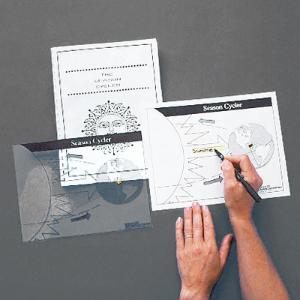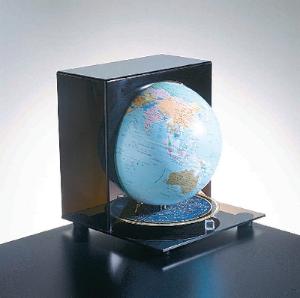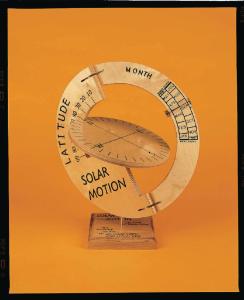Reasons for the Seasons; Earth Science Facts to Make their Day
All Grade Levels
As the seasons change, the curious minds in your class may wonder why the number of daylight and nighttime hours also changes. You can spin the Earth’s trek around the Sun into fascinating lessons about the solstice and the science of the seasons.
Students may be aware that the Earth spins and revolves around the Sun. But your lessons can deepen their knowledge by unraveling how Earth’s position in its orbit and the tilt of its axis cause the seasons, affect temperature, and the amount of daylight each hemisphere gets. When anyone tries to tell them it’s colder in the winter or hotter in the summer because the Earth’s farther from or closer to the Sun, they can respond, “Hey, that’s just a myth, buster!”
What’s the reason for the seasons?
Students learn early that each full spin, or rotation of the Earth, represents one full day and each lap around the Sun is one year. If you encourage your class to look at it from all angles, they’ll discover more revealing details about the science behind the changing of the seasons throughout the year.
Earth’s tilt
The first angle (23.5 degrees to be exact) to investigate is the Earth’s tilt. The Earth is tilted at a 23.5-degree angle relative to the Earth’s orbital plane around the Sun. Speaking scientifically, that’s called the Earth’s obliquity. This tilt causes the Sun’s light to shine differently on Earth at different times of the year.
The most common theory about how Earth got its tilt is that it collided with another prototype planet (called the Theia Impact). But one thing is sure; without that fortuitous tilt, there would be no seasons as we know them today. Let’s take a moment to thank the gravitational pull of our Moon for its role in keeping the Earth’s tilted axis stable! For such a little fella (a little over a ¼ the size of Earth), the Moon pulls a lot of weight!
If Earth hadn’t been knocked slightly off-kilter, life on Earth would be grim. Humans wouldn’t survive the endless winter of the high latitudes; the few humans alive would have to huddle together in the planet's equator. There would be a profound negative impact on the environment, vegetation, animal life, and disease-carrying insect populations would soar.1 Earth's 23-degree tilt helps create seasons with enough balance that life can easily survive.
Earth’s rotation and revolution around the Sun
When the Sun’s rays travel towards Earth, they hit both the Northern and the Southern Hemispheres. Earth’s tilted axis “always” points in the same direction. * Because of this, the part of Earth that receives the most direct Sun rays changes as the Earth travels along its elliptical orbit around the Sun. That’s why seasons in the Northern Hemisphere occur at opposite times from those in the Southern Hemisphere. When one hemisphere is tilted towards the Sun, it receives more light and energy than the opposite hemisphere.
For example, if the Southern Hemisphere is tilted towards the Sun, it will get more direct rays, creating more heat, causing summer for the folks in Australia, Brazil, and other countries below the Equator. On the other side of the world, in the Northern Hemisphere, they’ll get indirect rays from the Sun, making it wintertime in countries like the United States, Germany, or France. As the Earth makes its way around the Sun, the Northern Hemisphere will get its turn to bask in more direct Sun rays as the northern pole tilts forward towards the Sun. * “Always” points in the same direction—meaning currently. Earth’s axis currently points toward Polaris (the North Star). Arm your students with the jaw-dropping fact that Polaris will not always be the North Star! The Earth’s axis is slowly wobbling away from Polaris. In another 13,000 years, it will point toward the new North Star, called Vega.2
The Poles and Equator
Areas of the planet that get the Sun’s direct rays, like the Equator, get more heat than regions like the poles that receive indirect rays. The Equator is where the hours of light and darkness are equal, and there is little temperature change throughout the year. Lowlands around the Equator generally have a tropical rainforest climate (equatorial climate). Instead of summer, autumn, winter, and spring, these regions typically experience “wet” or “dry” seasons.
Did you know…?
- There is actually a place on the Equator where you’ll find snow. The Equator’s highest point is 4,690m, on the south slopes of Volcán Cayambe in Ecuador.3 Now that you know, you can add skiing at the Equator to your bucket list!
- The fastest sunrise and sunset rates in the world are at the Equator, taking only a matter of minutes. Because the Sun’s path across the sky is practically perpendicular to the horizon, the Sun takes only two minutes to cross the horizon on the Equinox dates. Guess that’s what Rudyard Kipling meant when he wrote, “On the road to Mandalay, Where the flyin’ fishes play, An’ the dawn comes up like thunder outer China ‘crost the Bay!”
If you really want to experience extreme variations in seasons or length of daytime hours, the Poles are the place to be. It’s mind-blowing to consider that, within 23.44° latitude of the poles, there are some days when the Sun never goes down (Midnight Sun) and other days when the Sun never rises (Polar Night)! 4
Earth’s tilt, rotation around its axis, and orbit around the Sun join forces to create the glorious seasonal changes that we all love and need.
What is the solstice?
“No winter lasts forever; no spring skips its turn.” — Hal Borland, author and naturalist. The solstice marks either the start of winter or the start of summer.
A 2013 YouGov survey found that 25% of Americans rate summer as their favorite season. That’s second to fall, with 29% preferring the comforts of the season. Sorry winter, your icy winds are only preferred by 7% of us.
Winter solstice
If your students want to celebrate the official start of winter, tell them to mark the winter solstice on their calendar. Winter (December) solstice, aka hibernal solstice, occurs twice a year, when the Sun is farthest south in the Northern Hemisphere (December 21 or 22) and farthest north in the Southern Hemisphere (June 20 or 21). During the winter solstice, the Sun shines most directly on the Tropic of Capricorn, 23.5 degrees south of the Equator.5
At the winter solstice, the Sun travels the shortest path through the sky, making it the shortest day and the longest night. Not to worry, though; every day after that will get longer and longer until we hit spring.
Love it or hate it, winter is the only time you have a chance to get a snow day!
Summer solstice
The summer solstice is the opposite of the winter solstice. Depending on the calendar’s shift, the summer solstice occurs sometime between June 20 and June 22 in the Northern Hemisphere and between December 20 and December 23 in the Southern Hemisphere. During the summer solstice, the Sun shines most directly on the Tropic of Cancer, 23.5 degrees north of the Equator, giving its most direct energy on Earth to the Northern Hemisphere.
If the days feel longer in the summer, it’s not your imagination. At the summer solstice, the Sun travels the longest path through the sky, so that day has the most daylight, and the Sun is highest in the sky. When the North Pole is tilted toward the Sun, we get more hours of sunlight in the Northern Hemisphere. In the summer, the Sun rises earlier in the day and sets later every night.
Equinox means “equal” so, the days and night are of equal length.
At the equinoxes, the Earth’s axis isn’t tilted toward the Sun; instead, it’s perpendicular to the Sun, making both the day and night about 12 hours long across the whole of the planet.5 An equinox is the time of year when the plane of Earth’s Equator passes through the geometric center of the Sun’s disk. This happens twice each year, around March 20 (start of spring, aka vernal equinox) and September 23. If you were standing at the Equator during the equinox, you’d find the Sun exactly overhead. It’s the only time when the Sun’s rays strike the Earth exactly perpendicular to its surface (called the subsolar point).
Your students can check out this chart for the upcoming solstice and equinox dates and times. They can chart the Earth’s journey around the Sun to see how its axis aligns perfectly to reflect these events.
Upcoming solstices and equinoxes
Timeanddate.com
1.http://astronomy.nmsu.edu/geas/lectures/lecture06/slide04.html and https://www.livescience.com/18972-earth-seasons-tilt.html 2. https://www.nationalgeographic.org/encyclopedia/axis/ 3. http://volcano.oregonstate.edu/cayambe 4. https://www.accessscience.com/content/midnight-sun/424730 5. https://www.britannica.com/science/winter-solstice 5. http://www.physicalgeography.net/fundamentals/6h.html
Recommended products
[StartProductBlock]

Season Cycler Lab Activity
Students can use a step-by-step procedure to mark, label, and rotate the Earth to illustrate and answer questions on solar intensity, rotation, and revolution, and angles of radiation.
[EndProductBlock]
[StartProductBlock]

Sun, Seasons, and Constellations Model Set
Demonstrate how Earth’s motions affect seasons, climate, and visible constellations. Students experiment with Earth’s seasonal and regional temperature variations, equinox and solstice, rotation, and orbit.
[EndProductBlock]
[StartProductBlock]

Orbit Tellurium 2
Demonstrate night and day, the seasons, phases of the Moon, and eclipses with this robust and flexible model.
[EndProductBlock]
[StartProductBlock]

Seasonal Demonstration Globe
An economical way to show Earth’s rotation and seasons. Students observe the Earth, tilted on its axis, as it rests on a disk divided into months and days of the month. They see what part of the planet is tilted toward the Sun, indicating which areas are experiencing warmer summer months.
[EndProductBlock]
[StartProductBlock]

Solar Motion Model
Demonstrate the Sun's actual path through the sky for any place on Earth and any season of the year. This device helps students understand the basis of Earth’s seasons and the apparent solar behavior.
[EndProductBlock]
